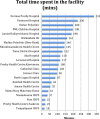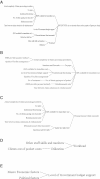Advancing the application of systems thinking in health: provider payment and service supply behaviour and incentives in the Ghana National Health Insurance Scheme--a systems approach
- PMID: 25096303
- PMCID: PMC4142471
- DOI: 10.1186/1478-4505-12-35
Advancing the application of systems thinking in health: provider payment and service supply behaviour and incentives in the Ghana National Health Insurance Scheme--a systems approach
Abstract
Background: Assuring equitable universal access to essential health services without exposure to undue financial hardship requires adequate resource mobilization, efficient use of resources, and attention to quality and responsiveness of services. The way providers are paid is a critical part of this process because it can create incentives and patterns of behaviour related to supply. The objective of this work was to describe provider behaviour related to supply of health services to insured clients in Ghana and the influence of provider payment methods on incentives and behaviour.
Methods: A mixed methods study involving grey and published literature reviews, as well as health management information system and primary data collection and analysis was used. Primary data collection involved in-depth interviews, observations of time spent obtaining service, prescription analysis, and exit interviews with clients. Qualitative data was analysed manually to draw out themes, commonalities, and contrasts. Quantitative data was analysed in Excel and Stata. Causal loop and cause tree diagrams were used to develop a qualitative explanatory model of provider supply incentives and behaviour related to payment method in context.
Results: There are multiple provider payment methods in the Ghanaian health system. National Health Insurance provider payment methods are the most recent additions. At the time of the study, the methods used nationwide were the Ghana Diagnostic Related Groupings payment for services and an itemized and standardized fee schedule for medicines. The influence of provider payment method on supply behaviour was sometimes intuitive and sometimes counter intuitive. It appeared to be related to context and the interaction of the methods with context and each other rather than linearly to any given method.
Conclusions: As countries work towards Universal Health Coverage, there is a need to holistically design, implement, and manage provider payment methods reforms from systems rather than linear perspectives, since the latter fail to recognize the effects of context and the between-methods and context interactions in producing net effects.
Figures










Similar articles
-
Provider preference for payment method under a national health insurance scheme: A survey of health insurance-credentialed health care providers in Ghana.PLoS One. 2019 Aug 26;14(8):e0221195. doi: 10.1371/journal.pone.0221195. eCollection 2019. PLoS One. 2019. PMID: 31449530 Free PMC article.
-
Is value-based payment for healthcare feasible under Ghana's National Health Insurance Scheme?Health Res Policy Syst. 2021 Dec 11;19(1):145. doi: 10.1186/s12961-021-00794-y. Health Res Policy Syst. 2021. PMID: 34895235 Free PMC article.
-
Payment methods for healthcare providers working in outpatient healthcare settings.Cochrane Database Syst Rev. 2021 Jan 20;1(1):CD011865. doi: 10.1002/14651858.CD011865.pub2. Cochrane Database Syst Rev. 2021. PMID: 33469932 Free PMC article.
-
Accrediting private providers with National Health Insurance to better serve low-income populations in Kenya and Ghana: a qualitative study.Int J Equity Health. 2018 Dec 5;17(1):179. doi: 10.1186/s12939-018-0893-y. Int J Equity Health. 2018. PMID: 30518378 Free PMC article.
-
What characteristics of provider payment mechanisms influence health care providers' behaviour? A literature review.Int J Health Plann Manage. 2018 Oct;33(4):e892-e905. doi: 10.1002/hpm.2565. Epub 2018 Jul 8. Int J Health Plann Manage. 2018. PMID: 29984422 Free PMC article. Review.
Cited by
-
Can health insurance protect against out-of-pocket and catastrophic expenditures and also support poverty reduction? Evidence from Ghana's National Health Insurance Scheme.Int J Equity Health. 2016 Jul 22;15(1):116. doi: 10.1186/s12939-016-0401-1. Int J Equity Health. 2016. PMID: 27449349 Free PMC article.
-
Advancing the application of systems thinking in health.Health Res Policy Syst. 2014 Aug 26;12:50. doi: 10.1186/1478-4505-12-50. Health Res Policy Syst. 2014. PMID: 25160646 Free PMC article. No abstract available.
-
Why did Ghana's national health insurance capitation payment model fall off the policy agenda? A regional level policy analysis.Health Policy Plan. 2021 Jun 25;36(6):869-880. doi: 10.1093/heapol/czab016. Health Policy Plan. 2021. PMID: 33956959 Free PMC article.
-
Understanding key drivers of performance in the provision of maternal health services in eastern cape, South Africa: a systems analysis using group model building.BMC Health Serv Res. 2018 Nov 29;18(1):912. doi: 10.1186/s12913-018-3726-1. BMC Health Serv Res. 2018. PMID: 30497460 Free PMC article.
-
What alternative and innovative domestic methods of healthcare financing can be explored to fix the current claims reimbursement challenges by the National Health Insurance Scheme of Ghana? Perspectives of health managers.Cost Eff Resour Alloc. 2021 Oct 9;19(1):69. doi: 10.1186/s12962-021-00323-2. Cost Eff Resour Alloc. 2021. PMID: 34627287 Free PMC article.
References
-
- WHO. Sustainable health financing, universal coverage and social health insurance. World Health Assembly Resolution 58.33 (2005) 2005. http://apps.who.int/iris/bitstream/10665/20383/1/WHA58_33-en.pdf?ua=1.
-
- UN. United Nations General Assembly. Sixty seventh session. Agenda item 123. Global Health and Foreign policy A/67/L.36. 2012. http://ncdalliance.org/sites/default/files/resource_files/Global Health and Foreign Policy resolution 201.
-
- Kutzin J. A descriptive framework for country level analysis of health care financing arrangements. Health Policy. 2001;56:171–204. - PubMed
-
- Jegers M, Kesteloot K, De Grave D, Gilles W. A typology for provider payment systems in health care. Health Policy. 2002;60:255–273. - PubMed
Publication types
MeSH terms
LinkOut - more resources
Full Text Sources
Other Literature Sources
Medical
Research Materials

